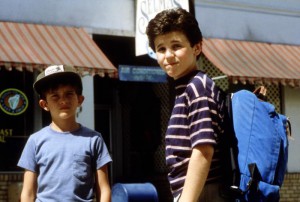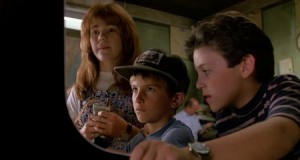The Wizard 
Directed by Todd Holland
Screenplay by David Chisholm
1989, USA
Although e-sports have long been a part of video game culture since the early 70’s, competitions saw a large surge in popularity in 1989 when Universal Pictures produced The Wizard, about a trio of kids who make their way to a national Nintendo video game championship (Video Armageddon) for a grand prize of $50,000. The charismatic and rising star of television’s Wonder Years, Fred Savage, stars as Corey, a boy who escorts his deeply traumatized younger half-brother Jimmy (Luke Edwards) away from a group home and sets off on a cross-country trek, chased by their father (Beau Bridges), their older brother (Christian Slater), and a child-finder, hired by their mother to bring him back home. Along the way they meet little Haley (Jenny Lewis) and discover that Jimmy is a real prodigy when it comes to video games. They make a stop off in Reno, hustle at some arcades, gamble at a casino and do whatever it takes to get to their destination on time. There’s a ridiculous comic subplot involving the child detective maliciously trying to stop Bridges from finding his sons and a secondary side-story about a competitive gamer named Lucas Barton, always getting in the way.
 Nintendo didn’t really need a boost in advertising back in 1989. The Nintendo Entertainment System was the best-selling gaming console of its time, and helped revitalize the US video game industry following the video game crash of 1983. With the NES, Nintendo introduced a now-standard business model of licensing third-party developers, and authorizing them to produce and distribute titles for Nintendo’s platform. More importantly, they placed priority on their exclusive titles making the likes of Zelda, Link, Mario and Luigi household names. Nintendo was everywhere. Kids had lunchboxes, watches, t-shirts; even magnets on their refrigerators. The next logical step was the big screen and Nintendo’s plan was to use The Wizard as a catalyst to publicize the release of Super Mario Brothers 3 and the Powerglove. Arguably the most famous scene in the entire movie involves the Power Glove controller, and the infamous line reading: “I love the Power Glove. It’s so bad”. What’s more, this section of the story culminates in a video game tournament that shows the first footage of Super Mario
Nintendo didn’t really need a boost in advertising back in 1989. The Nintendo Entertainment System was the best-selling gaming console of its time, and helped revitalize the US video game industry following the video game crash of 1983. With the NES, Nintendo introduced a now-standard business model of licensing third-party developers, and authorizing them to produce and distribute titles for Nintendo’s platform. More importantly, they placed priority on their exclusive titles making the likes of Zelda, Link, Mario and Luigi household names. Nintendo was everywhere. Kids had lunchboxes, watches, t-shirts; even magnets on their refrigerators. The next logical step was the big screen and Nintendo’s plan was to use The Wizard as a catalyst to publicize the release of Super Mario Brothers 3 and the Powerglove. Arguably the most famous scene in the entire movie involves the Power Glove controller, and the infamous line reading: “I love the Power Glove. It’s so bad”. What’s more, this section of the story culminates in a video game tournament that shows the first footage of Super Mario  Brothers 3 before the actual release of the game. The Wizard became one of the first movies to explore commercial advertising opportunities targeted at gamers within a film and ironically for a film that has an awful lot to do with interactive entertainment, director Todd Holland wasn’t a huge fan of the medium. Super Mario Bros. 3 went on to become one of the best selling games in history and there wasn’t a gamer who watched The Wizard that didn’t want the Powerglove. The movie however was a box office flop and was panned by critics nation wide who called it nothing but a giant promotional tool. But the truth is, Nintendo was refreshingly hands-off with the film-making process; it wasn’t even their idea to put the Powerglove into the film. Sure Nintendo sought to profit from the project, but if anyone is to blame for the poor quality of the picture, it isn’t them.
Brothers 3 before the actual release of the game. The Wizard became one of the first movies to explore commercial advertising opportunities targeted at gamers within a film and ironically for a film that has an awful lot to do with interactive entertainment, director Todd Holland wasn’t a huge fan of the medium. Super Mario Bros. 3 went on to become one of the best selling games in history and there wasn’t a gamer who watched The Wizard that didn’t want the Powerglove. The movie however was a box office flop and was panned by critics nation wide who called it nothing but a giant promotional tool. But the truth is, Nintendo was refreshingly hands-off with the film-making process; it wasn’t even their idea to put the Powerglove into the film. Sure Nintendo sought to profit from the project, but if anyone is to blame for the poor quality of the picture, it isn’t them.

 the Block, to name just a few. Nintendo isn’t responsible for how disappointing The Wizard is; Universal Pictures is. The Wizard is hackneyed and shallow and whatever merits it has, clash against the gross commercialism. The Wizard is also one of those strange 80’s family films that you just can’t make these days, featuring gambling, death, violence, and mental health issues. The runaways’ actions provide anything but responsible role models for the children who make up the film’s target audience and the trek to California is accomplished primarily by illegal activities and a series of violent encounters between the kids’ father and the bounty hunter. WarGames was a massive hit at the time, and Tron and The Last Starfighter enjoyed modest success, but Universal Pictures never truly had faith in their premise. They were given a chance to revolutionize the video-game movie, just as Nintendo revolutionized the home-console market – and instead they completely failed.
the Block, to name just a few. Nintendo isn’t responsible for how disappointing The Wizard is; Universal Pictures is. The Wizard is hackneyed and shallow and whatever merits it has, clash against the gross commercialism. The Wizard is also one of those strange 80’s family films that you just can’t make these days, featuring gambling, death, violence, and mental health issues. The runaways’ actions provide anything but responsible role models for the children who make up the film’s target audience and the trek to California is accomplished primarily by illegal activities and a series of violent encounters between the kids’ father and the bounty hunter. WarGames was a massive hit at the time, and Tron and The Last Starfighter enjoyed modest success, but Universal Pictures never truly had faith in their premise. They were given a chance to revolutionize the video-game movie, just as Nintendo revolutionized the home-console market – and instead they completely failed.
 All that said; while the film is poor in many respects, it’s difficult to hate. There’s something wonderfully nostalgic about watching the kids play Double Dragon, Turtles in Time and Ninja Gaiden, both on the NES console and at the arcade. Sure The Wizard is full of 80s cheese, but for gamers, it’s also a perfect escape to a much simpler time when gamers grew up on old 8-bit Nintendo games that seemed impossible to beat without subscribing to Nintendo Power, as opposed to multi-platform deals whose secrets can easily be found while surfing the World Wide Web. Years before silver screen adaptations of Silent Hill, Resident Evil, Pokemon, and Super Mario Bros., it was extremely rare to see video games featured in film, much less mentioned. The Wizard didn’t do much to change this fact, nor did it go down as a timeless, cinematic classic, but it did develop an understandable cult following as the years went on, and it’s easy to understand why.
All that said; while the film is poor in many respects, it’s difficult to hate. There’s something wonderfully nostalgic about watching the kids play Double Dragon, Turtles in Time and Ninja Gaiden, both on the NES console and at the arcade. Sure The Wizard is full of 80s cheese, but for gamers, it’s also a perfect escape to a much simpler time when gamers grew up on old 8-bit Nintendo games that seemed impossible to beat without subscribing to Nintendo Power, as opposed to multi-platform deals whose secrets can easily be found while surfing the World Wide Web. Years before silver screen adaptations of Silent Hill, Resident Evil, Pokemon, and Super Mario Bros., it was extremely rare to see video games featured in film, much less mentioned. The Wizard didn’t do much to change this fact, nor did it go down as a timeless, cinematic classic, but it did develop an understandable cult following as the years went on, and it’s easy to understand why.
– Ricky D

Trivia:
There was a reunion with the cast and director in 2008 at the Alamo Draft House. There, Tom Holland revealed that an hour of footage was cut from the movie — which explains many of the plot holes.
Sadly, the film wasn’t the massive financial success that Universal had hoped for. It cost $6M to make, but only made $13M at the box office.
Many NES games appear in the arcade scenes. Contrary to popular belief, this was possible since Nintendo had an arcade cabinet called Play Choice Ten. These machines would let the gamer choose between a number of NES games and alternate freely between them until time ran out, at which time the gamer would have to insert another coin.
The sounds made by Lucas’ Power Glove as he punches its keys are the famous five tones from Close Encounters of the Third Kind (1977).
The version of Double Dragon (1987) that Jimmy is playing at the bus station is not in fact the arcade version of the game, but rather the Nintendo Entertainment System version of Double Dragon.
Participating theaters would distribute issues of “Pocket Power” a pocket-sized version of “Nintendo Power” magazine.
When Jimmy, Corey & Haley are hustling the teenagers at the restaurant, it shows the game Jimmy is playing as F-1 Dream but the actual game Jimmy is playing is Top Speed (1987).
Tobey Maguire makes a cameo as one of Lucas’s henchmen. It was his first acting role.
Games featured in The Wizard:
- Castlevania II: Simon’s Quest
- China Gate
- Contra
- Dr. Chaos
- Double Dragon
- F-1 Dream
- Mega Man 2
- Metroid
- Ninja Gaiden
- PlayChoice-10
- R.C. Pro-Am
- Rad Racer
- Rampage
- Super Mario Bros.
- Super Mario Bros. 2
- Super Mario Bros. 3
- Teenage Mutant Ninja Turtles
- Full Throttle/Top Speed
- Zelda II: The Adventure of Link

